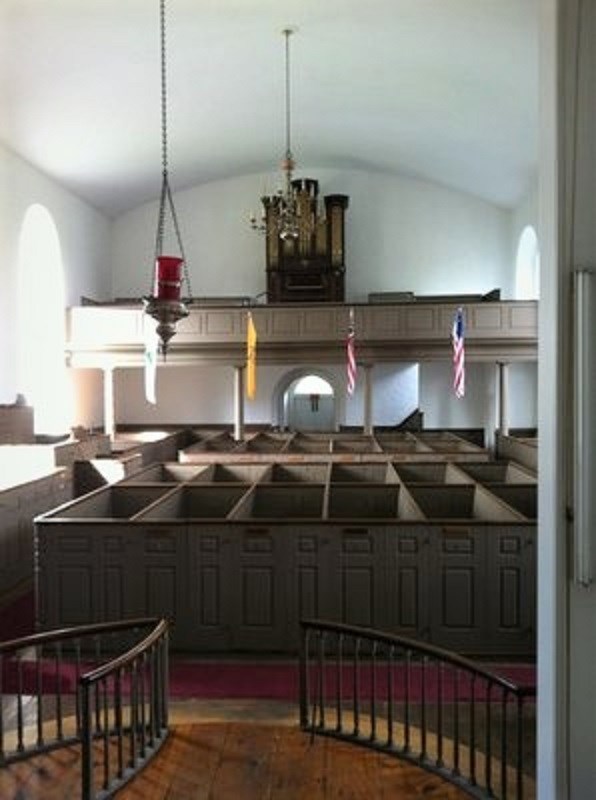Last updated: January 12, 2022
Article
Eternal Light/Sanctuary Lamp: Commemorating History & Religion at St. Paul's

NPS
EternalLight/Sanctuary lamp: Commemorating History & Religion at St. Paul’s
The small pewter lamp hanging gently from a chain at the eastern wing of St. Paul’s was donated to the church in a late afternoon ceremony, May 8, 1944, by Iphigene Ochs Sulzberger, wife of the publisher of The New York Times. A family heirloom, the lamp was brought to America in the mid 19th Century by Ms. Sulzberger’s great-grandfather Joseph Levy, who fled Germany in the turmoil that followed the failed revolution of 1848. It had been suspended at the front of the synagogue attended by the Levy family in Landau -- quite a journey, literally and symbolically, to an Episcopal Church in Westchester County.
In the synagogue, the lamp, ornamented with four cherub heads, served as an eternal light, or Ner Tamid, guarding the ark which housed the Torah scrolls, the Old Testament of the Bible; it represented God’s eternal presence and covenant with the Jewish people. The circular lamp also found a religious home at St. Paul’s since Christians revere sanctuary lamps as symbols for honoring the presence of Jesus and reserving the Blessed Sacrament. But the position in St. Paul’s of the carefully crafted lamp, chiseled with marks and initials indicating its probable 19th Century origin in the German city of Dresden, reflects important historical as well as religious themes.
Ms. Sulzberger donated the lamp to St. Paul’s in honor of her parents, Effie Wise Ochs and Adolph Ochs, who built the Times into the nation’s leading newspapers during his long tenure as publisher from 1896 to 1935. Before moving to New York, Adolph Ochs, originally trained as a printer, had developed successful papers in Tennessee. He inherited the sanctuary lamp from his mother Bertha Levy, who was a teenager, sympathetic to the revolution of 1848, when she reached American as a refugee a year before her parents. Ms. Levy received the lamp from her father, Joseph. The Levy and Ochs families lived in several locations in the South and the Midwest, so we can presume the lamp passed between family members and down through the generations across the Mississippi Valley.
Representing a great newspaper family that day at St. Paul’s, Ms. Sulzberger was pleased to offer the lamp to a site recognized for its connection with the origins of a free press in America through the famous Election of 1733, conducted on the Village Green at St. Paul’s, and documented in the inaugural issue of The New York Weekly Journal. The exclusion of Quaker voters at the election and the subsequent legislation protecting their right to vote is regarded as a milestone in the development of freedom of religion in early America, linking the site to a second prized freedom in the First Amendment. The parallel of a Jewish family accepting an invitation to visit a Protestant church and donating a valued religious family heirloom was recognized by participants in the ceremony on that May afternoon. A ceremony blessing the lamp was led jointly by a Sulzberger relative, Rabbi Jonah B. Wise of New York City’s Central Synagogue, and the St. Paul’s rector, Rev. Harold T. Weigle, who often heralded the church’s connections to those first amendment freedoms. Accepting the gift in the church sanctuary, recently restored to its original 1787 appearance, Rev. Weigle cited the Bill of Rights as America’s “common heritage, regardless of race or religion.”
Confirming the country’s reverence for the First Amendment of the Bill of Rights was a poignant exercise since on that day American soldiers were fighting on two fronts in World War II against armies from countries characterized by brute intolerance and fascism. It was one month before the critical D-Day invasion at Normandy. Certainly participants in the ceremony had a direct connection to the war through family or friends serving in the American armed forces; many journalists, including some from the Times, were killed while covering the conflict. The service welcoming the lamp was conducted late in the afternoon, since St. Paul’s, located in the shadows of large oil tank storage facilities, was part of an evening blackout zone as a precaution against potential enemy bombing raids.
